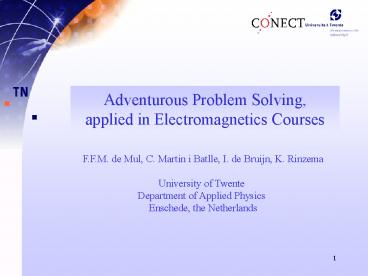Adventurous Problem Solving, applied in Electromagnetics Courses - PowerPoint PPT Presentation
Title:
Adventurous Problem Solving, applied in Electromagnetics Courses
Description:
Adventurous Problem Solving, applied in Electromagnetics Courses F.F.M. de Mul, C. Martin i Batlle, I. de Bruijn, K. Rinzema University of Twente – PowerPoint PPT presentation
Number of Views:101
Avg rating:3.0/5.0
Title: Adventurous Problem Solving, applied in Electromagnetics Courses
1
Adventurous Problem Solving,applied in
Electromagnetics Courses
F.F.M. de Mul, C. Martin i Batlle, I. de Bruijn,
K. Rinzema University of Twente Department of
Applied Physics Enschede, the Netherlands
2
CONECT
- cooperation between Physics Departments of
- Universities of Twente / Delft / Amsterdam (VU) /
Utrecht - objectives
- development of Physics CAI for exchange via
Internet - 1997-2000/1
- UT-project
- Integrating Mathematics in Physics Teaching
3
CONECT - UT
- Project group
- C. Martin i Batlle Ph.D-student research
- K. Rinzema postdoc development
- I. de Bruijn didactic support
- M.J. Peters magnetism
- F.A. van Goor optics
- F.F.M. de Mul EM project leader
4
Objectives
- development of self-service education
- to improve mathematical understanding and
skills, - especially for use in EM
- using symbolic algebraic software
- in the form of separate learning activities
- all via Internet
5
Pillars
- Integrating Mathematics in Physics
- Adventurous Problem Solving
- Additional to normal teaching activities
(classes, etc.)
6
Integrating Mathematics in Physics
- scalar and vectorial integrations
- multidimensional integrations
- using physical integration elements
- Gauss, Stokes, Ampere laws
- underlying mathematics
- coordinate systems, vectors, -products,
- grad, div, rot,
- 3D-viewing
7
Internet material developed for EM
- Problems including Integration steps,
- (with recording the students steps)
- Adventurous Problem Solving
- Exercises on Math applications in Physics
- PPT-presentations of classroom problems
- PPT-presentations about notoriously difficult
subjects - Special Presentation Magnetism in orders of
magnitude
8
Adventurous Problem Solving - 1
The Systematic Problem Solving Approach (SPA)
Ideal case
9
Adventurous Problem Solving - 2
The Systematic Problem Solving Approach (SPA)
10
Adventurous Problem Solving - 3
Analysis
Relations
Conclusions
Reflection
Approach
Calculations
11
Adventurous Problem Solving - 3
CAI- Problems
E1 SPA Electric field of a long straight, homogeneously charged wire
E2 SPA Electric field of a segment of a homogeneously charged straight wire
E3 APS Electric field in the point above an infinite, homogeneously charged plane (using strip or ring integration)
E4 APS Electric field above, below and in a thick charged plane with charge density varying over thickness (using integration)
E5 APS The same, but with Gauss Law.
M1 APS Magnetic field of a uniform surface current flowing over an infinite strip with finite width.
M2 APS Magnetic field on the axis of a disk with finite radius and with non-uniform circular current density.
M3 APS Magnetic field of a long thick wire with non-uniform current density (with Amperes Law).
12
Example of Adventurous Problem Solving
- Calculate magnetic field from a
- a distributed current density j
- Important steps
- analysis, symmetry,
- integration, control
Start Internet-connection
13
Example of an APS General Menu
14
Example of an APS Page
15
Coupling with algebraic symbolic software used
for expressions and integrations
- Intelligent control on students answers possible
- More than one coordinate system
- or solution strategy acceptable
- Format of answers (expressions) flexible
- Dimension analysis and control
16
Registration during problem solving
Name student, date/time, page, step, input by
student, right/wrong scoring
17
Analysis of students progress
Analysis software (in Delphi) APS_matrix
Start APS_matrix
18
Evaluation
- Interviews with students about
- User Interface
- Contents of the Internet course
- Adventurous Problem Solving versus
Systematic Problem Solving Approach - Results and Efficiency
- Experiments to measure the Learning Effect
- Various tests at various times during course
19
User Interface
- General satisfaction about
- navigation
- interaction
- presentation of information
- Less satisfaction about
- Demands for use of precise notation implied
- by algebraic software
Contents
- Satisfaction about
- The type of problems in CAI
- Feedback options
- Help pages
20
APS Satisfaction
21
Adventurous Problem Solving versus Systematic
Problem Solving Approach
- Two conflicting opinions
- Pro APS (69)
- you have to come up with your strategy
yourself - better overview for figuring out the strategy
- Contra APS (29 )
- messy
- to learn the structure of problems you need a
- structured and pre-described strategy
22
Results and Efficiency
- CAI-problems using APS
- are complementary to the course
- are tackled in a more elaborate way than on
paper, - especially the Analysis stage
- improve the Math skills with a factor
proportional to - the time invested
- but are considered less effective for problem
solving - than special problem tutorials and the study of
worked-out problems
23
Learning Effects (1)
- Aim
- Measuring learning effect of CAI in
- Integration Mathematics in Physics
- Method
- Experimental and control group
- Two tests (begin / end of course)
- Open questions/problems
- Various math subjects (diff./integr./coord./vecto
rs) - Analysis of tests using co-variance formalism
24
Learning Effects (2)
- Results
- The experimental group shows
- improvements in skills about
- coordinates, differential elements, integrals and
dimensions - no difference with control group concerning
vectors - no improvement in differential operators
(grad/div/rot) - After the exam both groups have the same level
25
Learning Effects (3)
- Conclusions
- CAI has profound effect, especially at
beginning of the course - Important advantage
- During the course, students are less hindered by
insufficient math skills, and can concentrate on
Physics
26
Adventurous Problem Solving,applied in
Electromagnetics Courses
The end































